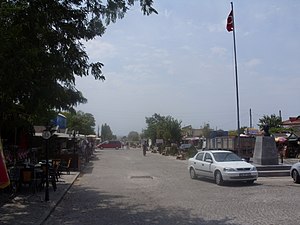Alçıtepe
Alçıtepe, also known by its former name, Krithia (Greek: Κριθία), is a small village on a commanding high plateau in the Eceabat District of Çanakkale Province, Turkey, about 4 miles from Cape Helles, the tip of the Thracian Chersonesos, now Gallipoli Peninsula.

Krithia was named after the grain "krithos", which in Greek means "barley"; a nearby cape was also called Krithea (Κριθέα) in Byzantine times, now Akbaş Burnu.[1] In the Book of Navigation of the Ottoman admiral Piri Reis (1521), it is recorded as Kirte.[1]
At the turn of the 20th century, about 450 Greek families lived in the village.[1] In October 1914, a military mission arrived at the village.[2] Turkish soldiers with fixed bayonets surrounded the village and forced the evacuation of each house in turn. Then, under the eyes of their officers, they seized everything they could lay their hands on.[2] Stripped of everything they possessed, the inhabitants in despair had to seek refuge in Madytos.[2]
During the Gallipoli campaign, the village was an objective of the first day of the landing, 25 April 1915. It was never reached. Over the following months, Turkish defenders successfully repulsed several assaults by the invading British and French troops. More famously, the village was the site of the Battle of Krithia during the same campaign.
As a result, the settlement suffered extensive damage due to shelling: the two Greek churches were destroyed, and only few traces of its medieval and ancient past remain, such as a column in the village square or architectural elements reused as spolia.[1] Following the departure of the Greek population in the Greco-Turkish population exchange, the village was resettled with Turks from Romania in 1938.[1]
References
- Külzer, Andreas (2008). Tabula Imperii Byzantini: Band 12, Ostthrakien (Eurōpē) (in German). Vienna: Österreichische Akademie der Wissenschaften. pp. 475–476. ISBN 978-3-7001-3945-4.
- Persecution of the Greeks in Turkey, 1914-1918. Constantinople [London, Printed by the Hesperia Press]. 1919.